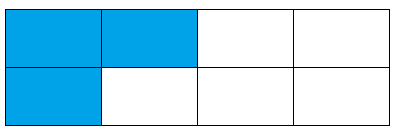A fraction represents a part of a whole. A fraction is written in the form:
where a is the numerator, and b is the non-zero denominator. The line separating the numerator and denominator is the fraction bar. The numerator represents the number of equal parts and the denominator indicates number of parts make up a whole. For example, in the fraction 3/8, the numerator 3 represents the 3 equal parts and the denominator 8 tells that the whole is consists of 8 equal parts. The figure below represents the fraction using a rectangle divided into 8 equal parts out of which 3 parts are shaded.
The fraction a/b is read as ‘a over b’, ‘a divided by b, ‘a out of b’, or ‘a by b’.
Let’s take an example of pizza. If a pizza is cut into 4 parts and you ate 1 part of it, then the fraction 1/4 represents that 1 out of 4 parts is eaten.
There are 3 types of fractions:
1) Proper fractions have numerator is less than denominator e.g 2/3, 6/11, 3/7, 5/9.
2) Improper fractions have numerator greater than denominator e.g. 5/2, 9/4, 8/3, 12/7.
3) Mixed fractions have a whole part and a fractional part e.g. ![]() The improper fraction can be converted to mixed number and mixed fraction can be converted to improper fraction.
The improper fraction can be converted to mixed number and mixed fraction can be converted to improper fraction.


